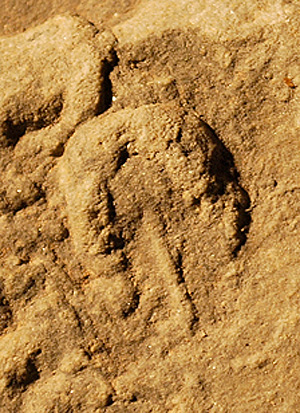Relatively few types of invertebrate body fossils are found at Blue Beach. The bodily parts of invertebrate animals do not fossilize as often because these are generally much less durable than the bones of vertebrates.

Resting-burrow of a limulid.

The Greg Wright Euproops with latex peel.
Ostracods are small ‘bivalved-crustaceans’ no larger than a sesame seed. Some of the shale beds contain vast numbers of these — they are the only abundant invertebrate body fossils. Some of the same ostracod families exist today in places like the Mississippi River delta, where saltwater and fresh mix. They are scavengers that feed on the carcasses of any dead animals that come to rest in the swamps, and are a major reason very few intact skeletons are ever found.
Spirorbids were tiny worms that built snail-like coiled tubes to live in, often attaching themselves to the undersides of dead mats of floating vegetation. These depended on the water currents to deliver small food particles. Like barnacles do today, they probably employed some kind of apparatus to catch these drifting particles and deliver them back to the worms’ mouth.
Euproops is a fairly small horseshoe crab that was fond of the nearshore habitat. These air-breathing arthropods are known as limulids; they still exist today, frequenting beaches as far north as Long Island in New York State. They were primarily highly mobile scavengers. They are one of the rarest arthropod fossils.